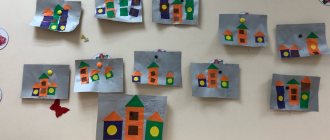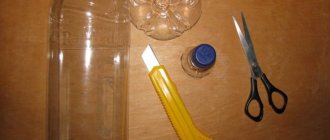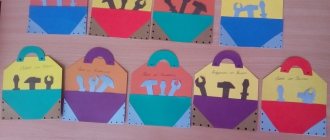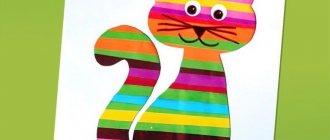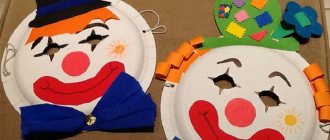Striped furniture
Applique:
Striped furniture.
To consolidate children’s knowledge on the topic “Furniture”, to activate the vocabulary on this topic;
Develop children's creativity and imagination;
Foster independence and activity;
Reinforce techniques for careful use of glue;
Learn to compose an image from strips of different lengths, following a certain sequence; place it correctly on the sheet;
Materials:
strips (10 cm and 5 cm * 11.5 cm), flannelgraph, strips of velvet paper, glue, napkins, maples, brushes.
1h
. Creating a game situation.
Reading the fairy tale “The Three Bears.” Remember the fairy tale “The Three Bears” with your children. Find out what Mashenka broke.
Show the children the stripes (one long, one short, for each child) and say that such stripes remain after the application and should be thrown away. But one day the stripes “revolted” and said that they could also be useful: “We can make different furniture,” they said.
Conversation with children about furniture. Find out what kind of furniture can be made from such strips.
You can sleep on the bed,
Chairs, table - rearrange.
I will put books in the closet,
I will cover the chairs.
Invite the children to draw an image of a table or bed on a flannelgraph. The teacher accompanies the drawing of the image with a comment, while naming the parts of the furniture: table top, legs, back, etc.
When laying out an image on a flannelgraph, the teacher asks the children to lay out the same image on sheets of paper.
We slept on the bed
Things have already been put away in the closet.
We sat on a chair
And we ate at the table.
3h
. Independent work.
After the children have posted all the images, offer to stick on the piece of furniture they like and give it to the three bears in the hut. When doing the work, the teacher reminds you of the sequence of laying out: first you need to lay out the long strip, and then the short ones; about the correct location on the sheet - in the middle, about accuracy. When gluing, learn about the rules for working with glue.
Ask the children what they did? What is this or that furniture for? Name the parts.
Lesson notes on art (application) “Bookmark” middle group
Application with design elements “Bookmark for a book”.
Middle group
Goal
: make a bookmark for a book.
Program content:
1. Teach children to cut and glue from colored paper and cardboard.
2.Develop the ability to work correctly with scissors. 3.Develop fine motor skills through practical work. 4.Develop aesthetic feelings. Materials for the lesson:
Colored cardboard, white and colored paper, templates, scissors, glue, glue brush, bookmark samples, box, book.
Progress of the lesson. 1. Organizational moment (surprise)
Educator: Guys, a package has arrived at our kindergarten!
I wonder who it's from? Here it is written to the children of the middle group from the school library. It’s strange, we’ve never received such packages before. What do you think is there? (Children's answers) To help you guess faster, listen to the riddle. Stories, fairy tales, comics, poems, coloring books live in them.
All the girls and boys love them. After all, this is... (Children's answers). - That's right, it's a book!
Only it’s kind of shabby, the pages are dog-eared and ugly. Guys, there is another letter attached here! Shall we read it? (Children's answers). “Dear guys, the librarian of school No. 6, Tamara Petrovna, writes to you. I sent you one of our books, you probably already noticed that it is shabby and its pages are curled, it was some of our slob students who brought the books to this state. You are our only hope, help our books! Solving a problem situation - How can we help, do you think? (Children offer various guesses). 2. Report the topic of the lesson.
- Well done, you guessed it, we can do a good deed with you, make bookmarks for books, so that sloppy students do not fold the pages, but bookmark the place where they stopped.
And I’ll show you how to do this now. 3. Sample analysis.
(Demonstration of ready-made bookmark samples).
-We will make a bookmark from colored paper and cardboard. (Explanation of the technology for making a sample bookmark: what is for what and how.). (Children ask questions, examine and discuss samples) 4. Preparing for work.
— Place the blank bookmark in front of you, roll it along the pressed lines.
Then take the template and attach it to the fold line, trace it with a simple pencil and only then cut it along the lines you drew. We will get a pattern like this. The next thing we will do is glue the edges of the bookmark with glue, and to make the bookmark more beautiful, we will insert such a beautiful rectangle of colored cardboard inside. Now you can do it yourself. (The teacher calls 2-3 children to reinforce what was said above.) You can add beautiful patterns to your bookmark (optional). “But first, let’s stretch our fingers so that they obey us.” Finger gymnastics. This finger wants to sleep. (alternately bend your fingers towards your palm.
This finger - jump into the bed!
Starting with the little finger. Then with your thumb,
This finger naps.
Touching all the others - “wake up”);
This finger has already fallen asleep.
Quiet, don't make noise, don't wake up your fingers. Fingers stood up. Hooray! (with the exclamation “Hurray!” - unclench your fists,
it’s time to go to kindergarten,
fingers spread wide.).
(Children do).
5. Productive activity of children
(Children complete the task, the teacher, if necessary, helps those who lag behind others).
Physical education minute.
Open the book quickly!
In the book there is a midge, a mouse, a bear, In the book there is a ball with a round side: up and down, jump and jump. There's an umbrella in the book, open it and sing, It's raining and you're dry! The pussy in the book is very close. In the color picture I stroke the pussy with my hand for a long time - After all, the pussy has such fur! 6. Summing up.
Educator: What a great fellow you are! They made such beautiful bookmarks, I think the books will love them too! I suggest you pack them in a parcel and send them to the library. Do you agree? (Children's answers). Thank you very much for your help.
Application for 1st grade
For children who have just come to school from kindergarten, it is necessary to organize exciting and interesting activities.
The main goal is to attract children to creativity as much as possible, to capture their attention and accustom them to active mental activity, initiative, flexibility and the desire for creative discoveries.
If children are interested in these activities at an early stage, then interest and involvement will grow in the future.
The most optimal method of conducting a lesson is a lesson in the form of a game with the addition of educational moments.
For example, when studying the topic “animals” or “plants” in the subject “Man and the World”, in a creative lesson you can be given the task of creating an image of an animal of your choice, while giving an additional task of memorizing some information on the topic.
Then it is worth organizing a presentation of the work, where each of the children will present the image they created with their own hands in public, accompanied by a short story.
Children 6-7 years old love fairy-tale and cartoon characters, because they actively watch cartoons, and their parents often tell them fairy tales. It is worth taking this feature into account and organizing classes on relevant topics.
Applications for 4th grade
At the last stage of primary education, children finally develop the skills necessary for creativity. All that remains is to focus on further developing skills in working with materials and revealing the abilities of each student.
Classes must be conducted with the aim of maximizing creative potential, so that each student creates a completely unique and extraordinary work.
At this stage, applique classes should be partially transferred to home in the form of homework. Parents can help their child in the creative process by bringing in their ideas and showing other techniques for creating an image.
Plus, working on an applique together is a great way to spend time together!
Regular applique practice can significantly enrich your imagination and even develop accuracy. This is a rather painstaking process, and, moreover, when the work is finished, it is necessary to clean the workplace.
Creative development when practicing applique in childhood helps people of all kinds of professions in adulthood, for example, designers, architects, engineers and constructors, since this type of creativity develops creative thinking.
Application for 2nd grade
Having become one year older, the children feel an even greater need to understand the world around them and creative self-realization. Applique lessons need to be made more challenging.
For example, by adding even more creative materials and increasing the choice of topics. After studying for a whole year at school, children begin to realize that with effort, it is possible to achieve something: both a good grade and praise from the teacher.
During this period, it is worth paying attention to technology and practical skills. Children should remember key points, if necessary, take notes on the course of actions and practice them.
